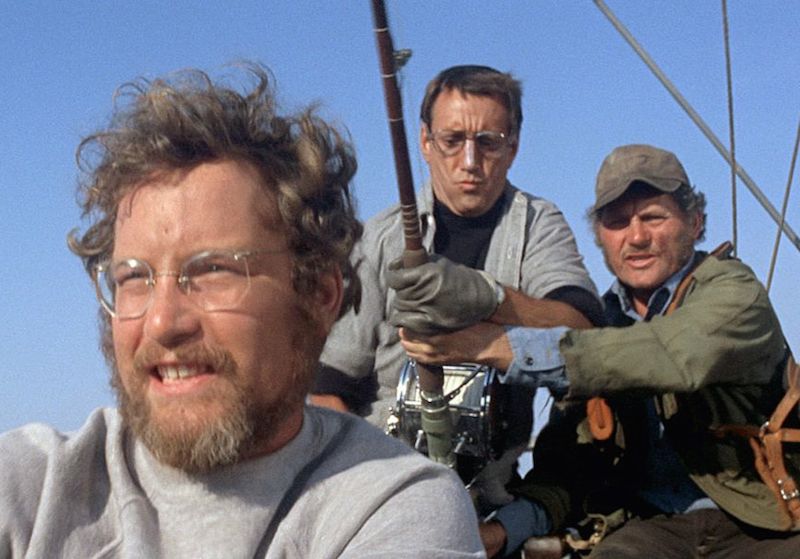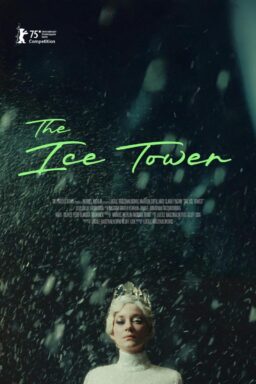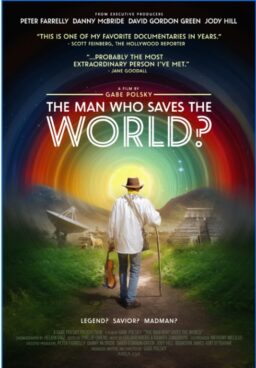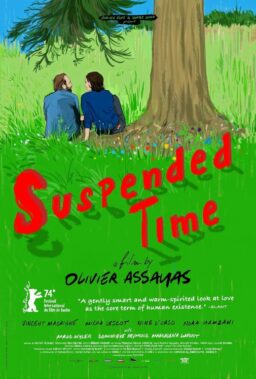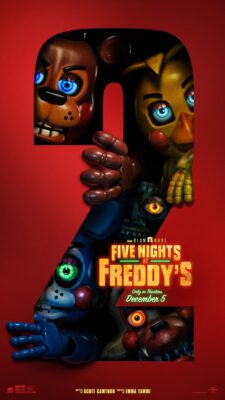It’s rather amazing how closely Richard Dreyfuss came to turning down his star-making role in Steven Spielberg’s 1975 masterpiece, “Jaws.” As detailed in Laurent Bouzereau’s essential documentary on the making of the film, Dreyfuss had just shot “The Apprenticeship of Duddy Kravitz,” which was meant to be a definitive big screen showcase for the actor following the success of George Lucas’ timeless 1973 nostalgia trip, “American Graffiti.” He figured that he’d rather pay a ticket to see Spielberg’s thriller than actually be in it, yet once he saw footage of himself as Duddy Kravitz, the 26-year-old performer became worried that he may no longer have a career after the film was released.
Thankfully for him, and for all of us, Dreyfuss went on to immortalize the role of Matt Hooper, a marine biologist who subverts all the tired stereotypes one would normally attribute to the “nerdy” member of an action movie trio. It’s Hooper who fights to hunt down the shark, volunteers to get in the water (on multiple occasions) and refuses to give in to the ridicule of bullies, instead making acerbic asides to the viewer such as, “They’re all gonna die.” All the while, the audience is laughing with him, not at him, so it’s no wonder that for the past 44 years, they’ve been cheering on his survival. I mentioned this to Dreyfuss during a brief yet illuminating phone call earlier this month, in anticipation of his January 31st appearance at a “Jaws” screening in Downers Grove, Illinois.
“There has always been a characteristic that I actually love to play, which is self-awareness,” noted Dreyfuss. “When a character is endowed with self-awareness, he knows how to laugh at himself. I haven’t thought about that in 40 years, but it’s something that I brought to the character of Hooper. There was no script, so we built the film as we went along. In the book, my character has an affair and he dies, and that’s why I say, ‘Don’t read the book.’”
One of my most memorable chance encounters during last summer’s Karlovy Vary International Film Festival was with Deborah Kolar, the eldest daughter of legendary actor Robert Shaw, who famously played the crusty seafarer Quint opposite Dreyfuss’ Hooper and Roy Scheider’s Chief Brody. She spoke with me at length about her father, whom she convinced to take the villain role in George Roy Hill’s 1973 Best Picture Oscar winner, “The Sting,” despite his character’s lack of screen time. Kolar also mentioned how her father had rewritten his monologue about the doomed crew of the Indianapolis, one of the greatest speeches in all of cinema. He was masterful at paring down words, taking out what could be conveyed nonverbally.
“Less was more with my father in terms of the screenplay,” Kolar told me. “He was often editing things like that, because he worked with Harold Pinter and was a great fan of his. Peter Benchley, bless his heart, obviously created the whole thing, but dad put his stamp on it and rewrote a lot of his speeches. I have a copy of the script, and you can see how my father crossed out the original story of the Indianapolis and rewrote it, along with a couple of other things too. Since my father was a writer, he did this on other pictures as well, such as Joseph Losey’s ‘Figures in a Landscape.’ I delighted in telling Spielberg that I had the ‘Jaws’ script. When he told me that he wanted it, I said, ‘But it’s a family heirloom!’”
The funny yet authentic tension that develops between alpha male Quint and brazen oceanographer Hooper is so convincing that one wonders whether it occurred when the cameras weren’t rolling. Though Shaw had fun taunting Dreyfuss in character between takes, they genuinely savored each other’s company offset.
“My father’s greatest delight was to tease people and see how much they could take it,” reminisced Kolar. “But he was incredibly warm and very sympathetic to people. He loved Richard. He thought he was terrific and really enjoyed working with him. I know that they did make fun of Roy a little bit because he was always perfecting his tan, and my dad, being an Englishman, had no interest in getting one himself. It was the time of Watergate, and I remember that he and Richard would watch it on television, and they’d have wonderfully heated discussions about what was going on.”
According to Dreyfuss, the camaraderie he shared with Shaw and Scheider had an enormous impact on their work in the film.
“If you are comfortable with an actor and you really enjoy their presence, it’s like butter,” Dreyfuss said. “Your ideas of timing and sharing all come together, and the work is so sweet. Robert was probably the largest personality I ever met. He was an epic human being, and it was a terrible thing that he died as young as he did. I just got a letter from Robert’s daughter [Rachel], and she told me that someone is making a movie about the visit to Martha’s Vineyard that Robert’s family made in the middle of the shoot. I’m a character in the movie, so I’m looking forward to that.”
Kolar laughs while recounting her story of the phone call she had with her father during the production of “Jaws.” She asked him how it was going, and he was really concerned, saying, “I think it’s going to be really, really hokey and bad. The shark doesn’t look real.” But when she asked him about the director, he replied, “He’s a young guy, but he seems to know what he’s doing.” Of course, “Jaws” became the highest-grossing movie at the domestic box office, and Shaw couldn’t have been more thrilled. When it opened, he was on the set of Richard Lester’s “Robin and Marian” with his close friend Sean Connery, and the records broken by Spielberg’s movie sparked a cheerful rivalry between the pair. Shaw loved to taunt him by saying, “I’m in the biggest box office hit,” and perhaps it’s no coincidence that Connery would later collaborate with Spielberg in 1989’s “Indiana Jones and the Last Crusade,” where he forges a similarly amusing comedic chemistry with co-star Harrison Ford.
Two years after the phenomenal success of “Jaws,” Dreyfuss re-teamed with Spielberg for another classic, “Close Encounters of the Third Kind.” Yet it was his endearing portrayal of a Broadway actor in Herbert Ross’ “The Goodbye Girl” that went on to earn him the Academy Award for Best Actor in 1978. During his acceptance speech, Dreyfuss made a point of thanking the film’s producer, Ray Stark, to whom he believed he owed everything. The son-in-law of Fanny Brice, Stark produced the original Broadway production of “Funny Girl” as well as its hugely successful 1968 screen adaptation.
“Ray was an extraordinary guy and he had one of those legendary attitudes,” recalled Dreyfuss. “It’s ‘what makes Sammy run.’ He knew who he was, so he enjoyed being Ray to the world. He was my best friend on a Monday and he was my worst enemy on a Tuesday, but he handed me my career, and I couldn’t say no to that.”
Though Dreyfuss has delivered hilarious work in many, many films, none of his performances have made me laugh more than the one he gives in Frank Oz’s 1991 farce, “What About Bob?” His portrayal of Dr. Leo Marvin, an uptight egotist whose sanity gradually unravels once a persistent patient (Bill Murray) follows him to his vacation home is one of the most uproarious comic slow burns in movie history, reminiscent of Gene Wilder’s tantrum when informed of the abnormal brain in Mel Brooks’ “Young Frankenstein.” By the third act of Oz’s film, Dr. Marvin’s frustration reaches such a boiling point that he removes all the consonants from his line, “Get out of my car!”, reducing the words to a roar of enraged vowels. Though Dreyfuss admits that he enjoyed playing characters who lose their cool, he no longer seeks out those sorts of roles—after all, how can one top perfection?
When it comes to some of Dreyfuss’ own personal favorite films in his career, he highlights titles such as Barry Levinson’s 1987 gem, “Tin Men,” and Tom Stoppard’s 1990 adaptation of his own play, “Rosencrantz & Guildenstern Are Dead.” He also says the character of Jay Trotter, a gambler who hits a hot streak in Joe Pytka’s 1989 comedy, “Let It Ride,” was “more fun to be than anything.” Like Dr. Marvin, Trotter is also prone to bursts of manic energy, and the casting of “Young Frankenstein”’s Teri Garr as his wife only heightens the Wilder comparisons. It also plays like somewhat of an in-joke that Dreyfuss and Garr are once again playing a couple whose marriage is on the rocks, twelve years after they were first paired in “Close Encounters.”
The Dreyfuss picture my family returned to more than any other throughout my childhood was Stephen Herek’s 1995 intimate epic, “Mr. Holland’s Opus.” Its empathetic portrait of a high school music teacher earned the actor his second well-deserved Oscar nomination, and it may be the only Hollywood film to succeed in channeling the cumulative emotional power of Frank Capra’s 1946 holiday perennial, “It’s a Wonderful Life.”
“The writer of that film [Patrick Sheane Duncan] was in a traffic jam in west LA,” remembered Dreyfuss. “A cop was walking by, and the writer asked, ‘What’s going on? Why are we stuck?’ The cop answered, ‘There are all these people up there who are striking.’ ‘Who?’ the writer asked, to which the cop replied, ‘Teachers.’ Then the writer got back in the car, turned around, went home and wrote that script in two weeks. These teachers were striking for better pay and better working conditions. They go into their own pockets to get paper and pencils. The other day, 600,000 teachers struck the LA Unified School District. They were all in front of City Hall in the pouring rain, and they stayed there. Whether we admit it or not, these are the last great heroes of our culture. Their salary should be tripled and they should be treated with the respect of college professors.”
Cast as Dreyfuss’ wife in the film was Glenne Headley, one of the most accomplished ensemble members of Chicago’s Steppenwolf Theatre Company, who passed away far too soon in 2017. Though “Mr. Holland’s Opus” was distributed by Disney and, like Capra’s work, was dismissed by some critics as sentimental, the sequences depicting the couple’s struggles in raising a deaf son are raw and harrowing, thanks in no small part to the acting.
“Each of the guys who played my sons at different ages were fantastic,” said Dreyfuss. “There was a little boy, a teenager and then there was the grown-up. The actor who played the grown-up son [Anthony Natale] is one of the lead actors of the National Theater of the Deaf. He is so beautiful, and watching him sign is so beautiful, that you’ll never forget it.”
Though Christian Bale is widely predicted to win the Best Actor Oscar this year for his frighteningly transformative work as Dick Cheney in Adam McKay’s “Vice,” I frankly prefer Dreyfuss’ take on the former Vice President, one of the most memorable parts of Oliver Stone’s 2008 film, “W.” No gimmickry or prosthetics are needed for the actor to embody the unsettling essence of his character, and the ways he influences those occupying the Oval Office without having to utter a word. When I mentioned to Dreyfuss the power that he radiates in his stillness, standing in a corner as Bush looks to him for approval, he said, “I went to Oliver and I said, ‘This is what I’d like to. I want to be in the shadows.’” In 2006, the actor founded The Dreyfuss Civics Initiative to educate youth on the fragility of our democracy and the flaws in our Constitution, which have ultimately enabled the existence of the Trump administration.
“Cheney’s not the precursor to the mess our country’s in now, he’s the yahoo who opened the door,” affirmed Dreyfuss. “When George Bush found out how Cheney had manipulated him, he cut him out of the second term completely, and had every reason and right to do that. Cheney was the first—I don’t know what you wanna call it—geopolitical realpolitik bulls—t artist, and he never should’ve been where he was at that time and place. As we said in our film, we are in Iraq for oil, and we are staying there. There’s a little bit of Cheney in all of us, and one of the things that you know as an actor are things like that. We don’t have to go far off pace to find Dick Cheney. We’ve all been venal, we’ve all been selfish and hypocritical, and you can find it in you. He had the perfect body of posture. From the lip down, he was screaming his contempt, and that was easy to play.”
Among the actor’s most vocal champions was our site’s founder, Roger Ebert, who singled out Dreyfuss in his original review of “Jaws” as the film’s “most inspired bit of casting.” As soon as Dreyfuss heard me utter Ebert’s name, he began to fondly reminisce about the critic.
“It was a great privilege to know Roger Ebert,” reflected Dreyfuss. “There was one day I told him, ‘I’m going to Vegas with some friends, you wanna come?’ And he went through a crisis of journalistic conscience. He wanted desperately to come and just be a pal, and he couldn’t because he was a journalist. I remember tossing that grenade to him, and I will never forget the agony he put himself through. He was a very serious film critic and a great guy. I liked him a lot.”
“What he and his partner invented on their show was a type of film criticism that people listened to,” Dreyfuss continued. “The only other person who ever really achieved this was James Agee when he worked for The New Republic in the late 40s. When Roger and Gene batted it back and forth, you listened. You could disagree, but you listened, and they knew how to express their opinion without spending a lot of time on it. They knew how to give people in the business the awareness that they had actually watched their film. Really watched it.”
For tickets to “An Evening Jawing with Richard Dreyfuss” at the Tivoli Theater, 5021 Highland Ave., in Downers Grove, on Thursday, January 31st, click here. VIP meet & greet receptions occur at 5pm and 6pm, with the Q&A following at 7:30pm and a screening of “Jaws” at 9pm.

